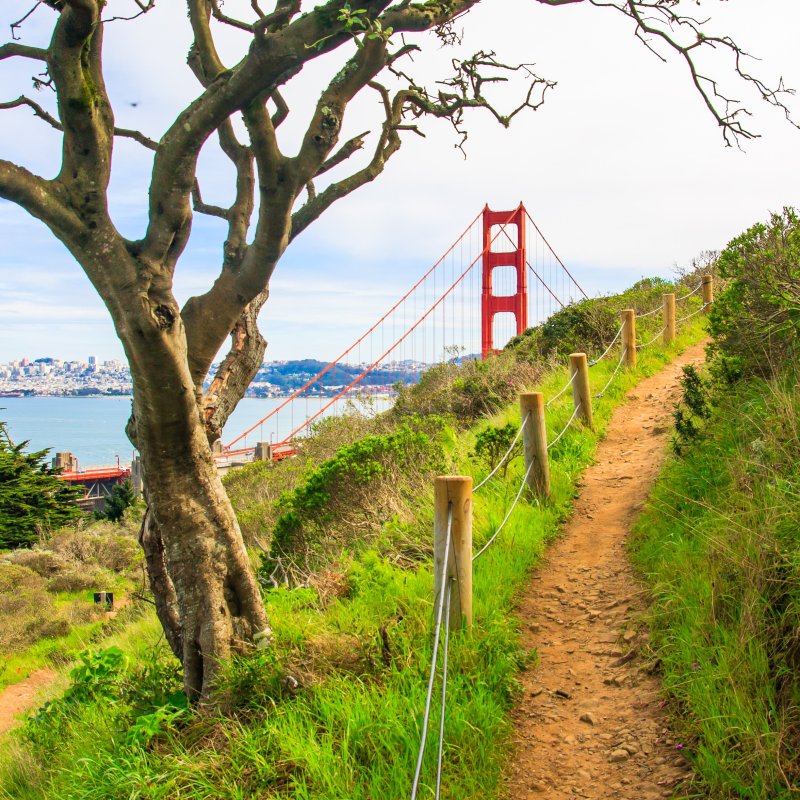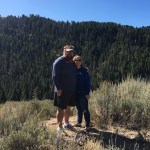
You know what’s on the south end of the Golden Gate Bridge: the Presidio, Fisherman’s Wharf, and the entire city of San Francisco. But do you know what’s on the north side of the bridge? Many visitors to San Francisco who drive across the Golden Gate Bridge pull off at the overlook at the north end of the bridge. They park in the parking lot, walk to the overlook to take photos of the bridge, and then they get back into their cars to go back across the bridge, unaware that they’re surrounded by hundreds of years of history.
Videos by TravelAwaits
On a recent trip to San Francisco, my wife and I decided to explore the Marin Headlands at the north end of the bridge, and we were surprised by what we found: historic military bases, a dog beach, missile silos, a marine animal hospital, and everything in between.
Here are nine things to know about visiting San Francisco’s Marin Headlands.
1. Instead Of Turning Around, Turn Right
The Golden Gate Bridge Vista Point is one of the most popular spots for visitors to San Francisco Bay. The standard itinerary is to drive across the bridge, get off at the overlook, take photos, and then take the loop road to the left and back onto the highway, heading south across the bridge. But a right turn leads to so much more.
That intersection (Highway 101 and Alexander Avenue) leads to two destinations. A right turn on Alexander Avenue will take you to Sausalito. A left turn will take you to the ramp for Highway 101 South. But if you take a right toward Sausalito, travel 900 feet, and then turn left on Bunker Road, you’ll be headed to the Marin Headlands.
Don’t worry — it’s easy to return to this point and back to Highway 101. But it’s amazing how many cars simply return to the highway and go back to San Francisco without checking out everything the Marin Headlands have to offer.

2. Be Sure To Visit Fort Baker
Once you’ve turned on Bunker Road, you’ll have two options. Straight ahead is the Baker-Barry Tunnel and access to the western part of the Marin Headlands. But if you follow Bunker Road down to the right, you’ll eventually end up at Fort Baker.
When it was an operating Army base, Fort Baker guarded the entrance to San Francisco Bay. It was converted into a park, but 25 of the original buildings still remain, as does the massive parade ground at the center of the site.
Perhaps the best way to visit the site is to take the cell-phone tour. There are a series of signs around the park with phone numbers on them. Call the number, listen to the recording describing the history of that location, and then follow the prompts to the next location (and the next phone number to call for another recording).
3. The Best Views Of The Golden Gate Bridge Are From The Moore Road Pier
At the southwest end of Fort Baker is an active Coast Guard station, and just beyond that station, on Moore Road, is the Moore Road Pier.
What’s significant about this pier? Not much. It is no longer an active pier with boats docking alongside it. But it does provide one thing: incredible views of the Golden Gate Bridge.
Park just beyond the Coast Guard station in the parking lot off of Moore Road. From there, it’s a short walk out to the Moore Road Pier. Walk all the way to the end for the best photos. Perhaps you’ll even catch a cargo ship traveling under the massive bridge.

4. There Are Two Routes To The Famous Loop Drive
The number-one attraction in the Marin Headlands is the loop drive. It climbs high above the Golden Gate Bridge to the north and west and provides stunning views of the bridge with the entire city behind. There are two ways to get to this loop road.
One route is to take the Baker-Barry Tunnel. This is the tunnel that you saw as you entered the park on Bunker Road. It’s a one-lane tunnel, so you’ll likely have to wait at a stoplight until the tunnel clears, but once you get the green light, you’ll be traveling underneath all of the traffic on Highway 101 and deep into the heart of the Marin Headlands. Once you come out of the tunnel, you’ll travel about a quarter of a mile to McCullough Road. Turn left on McCullough Road, and this will take you to the loop road.
If you’re coming from the Golden Gate Bridge Vista Point and aren’t traveling to Fort Baker, there’s a quicker way to the loop road. Follow all of the cars leaving the Vista Point and heading back to the Golden Gate Bridge southbound, but instead of getting on Highway 101, turn right on Conzelman Road. This will start your climb up to the loop road.
5. The Loop Drive Becomes A One-Way Road Starting At The Marin Headlands Vista Point
The main overlook on the loop road is the Marin Headlands Vista Point. From that point to the west, it’s an even more exciting drive, because the road becomes a one-way loop.
Don’t worry — there are a couple of roads that lead back out once you reach the end of the one-way road. And the views are more than worth the trip! The views of the entrance to San Francisco Bay are simply stunning.
If you’re worried about navigating the loop road, be assured that the road feels safe. It would feel unsafe if cars had to pass other cars on this very skinny road, but this is why the one-way loop was put in. You’ll travel along, appreciating the views all around without having to worry about approaching vehicles.

6. The Walk To Point Bonita Lighthouse Is Worth It
At the southwestern point of the Marin Headlands sits Point Bonita Lighthouse. It’s located at the end of a very skinny finger of land that extends into the Pacific Ocean.
Because it sits on a tiny sliver of land in the ocean, you cannot drive to Point Bonita Lighthouse. You can and should walk there, however. Park in the Point Bonita parking lot (near the end of the one-way loop road) and follow the signs to the lighthouse trail.
7. The Marine Mammal Center Is Free And Open To The Public
The Marine Mammal Center is an active animal hospital for sea mammals. It is open to the public daily and is free of charge.
At the center, you can expect to see mostly seals and sea lions that the employees are nursing back to health. During “pupping season,” you’ll get to see northern elephant seals and California sea lion pups.
The center offers private tours (for a fee) that allow you to see the full facility. The fee supports the hospital and its programs.

8. Rodeo Beach Is Dog Friendly
On my visit to the Marin Headlands, I found Rodeo Beach and the adjacent Fort Cronkhite the most surprising. You’re driving along this mountainous terrain containing everything from missile silos to lighthouses, and then you come upon a lagoon and a very large beach tucked into a valley.
The beach — Rodeo Beach — is dog friendly, so if you have your four-legged friend with you, this is the place to go. It’s not a sandy beach, so it’s not the spot for beach volleyball, but the different types of smooth, tiny rocks would make for an interesting beach experience for both you and your dog.
9. There Are Two Routes Back To The Golden Gate Bridge
When you are in this area (Rodeo Beach, the Marine Mammal Center, and Fort Cronkhite), it can feel like you won’t find your way back, especially since one of the roads you took to get there was a one-way road. But there are two routes back to the Golden Gate Bridge from here.
Both start with Bunker Road. Leaving Rodeo Beach, get on Bunker Road and head back east. Once you get to McCullough Road, you have a choice. Turn right on McCullough, and it will take you back to Conzelman Road. Follow Conzelman Road until it ends, and you’ll be right at the ramp for the Golden Gate Bridge.
You can also take Bunker Road back to the Baker-Barry Tunnel. Once you come out of the tunnel, follow Baker Road back to Alexander Avenue. Turn right, and this will take you to the ramp for the Golden Gate Bridge.
And what an end to your journey! Look right as you cross back over the Golden Gate Bridge, and you’ll see the Marin Headlands and all the wonderful places you’ve just experienced.
Planning a trip to San Francisco? Don’t miss these hidden gems, these fun and free things to do, and these great restaurants.
